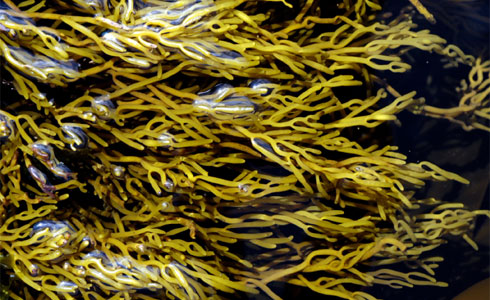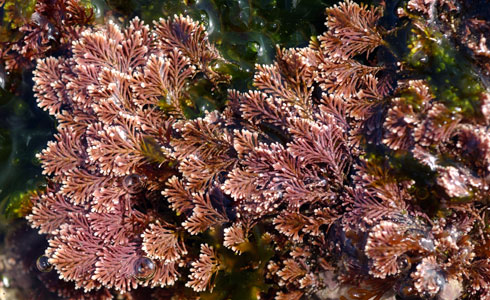- Home
- > Nature online
- > British natural history
- > Big Seaweed Search
- > Identify seaweeds
- > Seaweeds in rock pools
Primary navigation
Seaweeds in rock pools
Rock pools are home to some very common seaweeds and also to some more vulnerable species. Find out how to identify them.

Bifurcaria bifurcata
Location: Rock pools
Identification: Bifurcaria has rounded fronds that fork towards their ends and can grow up to 50cm long.
Facts: This species is only found in southwest Britain and doesn’t have a common name. We would like to find out exactly which locations it lives in, so that we can investigate whether its range is expanding or shrinking.

Green seaweeds, Ulva species
Location: Green seaweeds are found on almost all shores, in rock pools and attached to rocks or other organisms.
Identification: Fronds are either delicate, bright green and lettuce-like, or grow as tubes that look a bit like intestines. There are a number of different species, and these can be very difficult to tell apart. The common names for the green seaweeds are sea lettuce and gut weed.
Facts: Green seaweeds can become very abundant, but only on some shores and at certain times of the year. We want to find out as much as we can about when and where this occurs, so that we can investigate why it happens.

Green seaweeds in water, Ulva species

Red seaweeds, Corallina species
Location: Red seaweeds are mainly found on wave-washed rocks and in rock pools.
Identification: A stiff, finely-branched, coral-like pink seaweed made up of many tiny segments.
Facts: There are 3 species of Corallina in Britain. We are interested in finding out their distribution, as we think they might be particularly vulnerable to the effects of increased carbon dioxide levels in the oceans.

Common limpet, Patella vulgata
Location: The common limpet is found on all British coasts on rocks and in rockpools.
Identification: Limpets are shelled animals. The shell is cone-shaped and has irregular ribs that spread out from the tip of the shell. The soft body or 'foot' of the limpet is protected by the shell. When the tide is out, you normally only see the shell, which is firmly fixed to the rock. Common limpets can be up to 6cm long. There are 2 other species of Patella on British shores but they are difficult to tell apart.
Facts: Limpets are grazers, scraping seaweed spores off the rock with a tongue, called a radula, which is like a ribbon with rows of teeth. The common limpet has a 'home' that it always returns to after feeding. Sometimes you can see grooves or 'home scars' in the rock where a limpet used to live. They can live for 15 or more years.
Get involved
Help us find out more about these wonderful organisms by taking part in the Big Seaweed Search. You don't need to be an expert - just use our downloadable guides.
Related information
External links
Toolbox
- Contact and enquiries
- Accessibility
- Site map
- Website terms of use
- © The Trustees of the Natural History Museum, London
- Information about cookies
- Mobile
